control VAUXHALL VIVARO C 2020 Owner's Manual
[x] Cancel search | Manufacturer: VAUXHALL, Model Year: 2020, Model line: VIVARO C, Model: VAUXHALL VIVARO C 2020Pages: 289, PDF Size: 10.16 MB
Page 172 of 289

170Driving and operatingHill start assistThe system helps prevent unintendedmovement when driving away on
inclines.
When releasing the brake pedal after
stopping on an incline, brakes remain
on for further 2 seconds. The brakes
release automatically as soon as the
vehicle begins to accelerate.Ride control systems
Electronic Stability Control and Traction Control system
Electronic Stability Control (ESC)
improves driving stability when
necessary, regardless of the type of
road surface or tyre grip.
As soon as the vehicle starts to
swerve (understeer / oversteer),
engine output is reduced and the
wheels are braked individually.
ESC operates in combination with the Traction Control system (TC). It
prevents the driven wheels from
spinning.
The TC is a component of the ESC.
Traction Control improves driving
stability when necessary, regardless
of the type of road surface or tyre grip,
by preventing the driven wheels from
spinning.
As soon as the driven wheels starts to spin, engine output is reduced and
the wheel spinning the most is brakedindividually. This considerably
improves the driving stability of the
vehicle on slippery road surfaces.
ESC and TC are operational after
each engine start as soon as the
control indicator J extinguishes.
When ESC and TC operate, J
flashes.
9 Warning
Do not let this special safety
feature tempt you into taking risks
when driving.
Adapt speed to the road
conditions.
Control indicator J 3 112.
Page 173 of 289

Driving and operating171Deactivation
ESC and TC can be deactivated,
everytime it is required: press 9.
The LED in the button 9 illuminates.
A status message appears in the
Driver Information Centre when ESC
and TC are deactivated.
ESC and TC are reactivated by
pressing the 9 button again or in the
case that the vehicle is driven faster
than 30 mph.
The LED in the button 9 extinguishes
when ESC and TC are reactivated.
ESC and TC are also reactivated the
next time the ignition is switched on.
Fault
If there is a fault in the system, the control indicator J illuminates
continuously and a message appears
in the Driver Information Centre. The
system is not operational.
Have the cause of the fault remedied
by a workshop.
Selective ride controlCaution
The vehicle is designed to drive
principally on-road, but it also
enables driving off-road
occasionally.
However, do not drive on terrain
where the vehicle could be
damaged due to obstacles, such
as rocks among others and on
terrain with steep inclines and
poor grip.
Do not cross waters.
Caution
When driving off-road, sudden
motion and manoeuvres can
cause a collision or losing control.
Selective ride control is designed to
optimise traction in low-grip
conditions (snow, mud and sand).
It adapts to the terrain by acting on the
front wheels, in doing so this saves
the weight normally associated with a more conventional four wheel drive
system.
Page 174 of 289

172Driving and operatingSelective ride control allows to
choose between five driving modes:
● ESC off mode 9
● standard mode 2
● snow mode 3
● mud mode 4
● sand mode 1
The several modes can be activated
by turning the control.
An LED illuminates and a status
message appears in the Driver
Information Centre to confirm the
chosen mode.
ESC off mode 9
The ESC and Traction Control are
deactivated in this mode.
An LED in the button 9 illuminates.
ESC and Traction Control are
reactivated automatically from
30 mph or everytime the ignition is
switched on.Standard mode 2
This mode is calibrated for a low level of wheel spin, based on the differenttypes of grip generally encountered in
normal day to day driving.
Everytime the ignition is switched off,
the system is automatically reset to
this mode.
Snow mode 3
This mode adapts to the grip
conditions encountered by each
wheel when starting.
When advancing, the system
optimises wheel spin to guarantee the
best acceleration based on the
available traction. Recommended in
cases of deep snow and steep
inclines.
This mode is active up to a speed of
30 mph.
Mud mode 4
This mode allows considerable wheel
spin at start-up for the wheel with the
least grip, this removes mud and re-
establishes traction.Simultaneously, the wheel with the
most grip is provided with the most
torque possible.
This mode is active up to a speed of 50 mph.
Sand mode 1
This mode allows a small amount of
simultaneous wheel spin on the two drive wheels, enabling the vehicle to
advance and reduce the risk of
sinking.
This mode is active up to a speed of
75 mph.Caution
Do not use the other modes on
sand as the vehicle may become
stuck.
Page 175 of 289
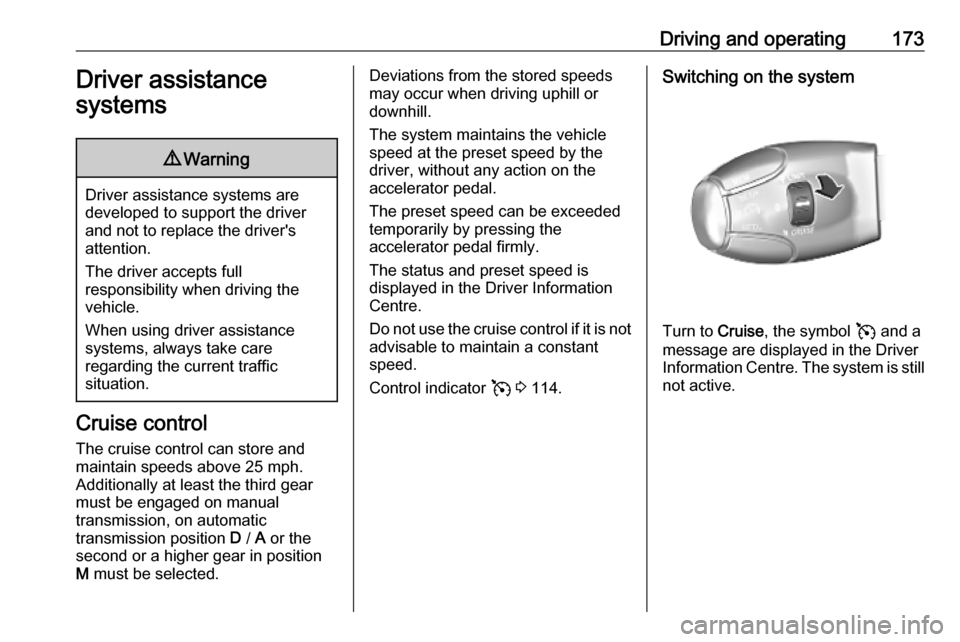
Driving and operating173Driver assistance
systems9 Warning
Driver assistance systems are
developed to support the driver
and not to replace the driver's
attention.
The driver accepts full
responsibility when driving the
vehicle.
When using driver assistance
systems, always take care
regarding the current traffic
situation.
Cruise control
The cruise control can store and
maintain speeds above 25 mph.
Additionally at least the third gear
must be engaged on manual
transmission, on automatic
transmission position D / A or the
second or a higher gear in position
M must be selected.
Deviations from the stored speeds
may occur when driving uphill or
downhill.
The system maintains the vehicle
speed at the preset speed by the
driver, without any action on the
accelerator pedal.
The preset speed can be exceeded
temporarily by pressing the
accelerator pedal firmly.
The status and preset speed is
displayed in the Driver Information
Centre.
Do not use the cruise control if it is not advisable to maintain a constant
speed.
Control indicator v 3 114.Switching on the system
Turn to Cruise, the symbol v and a
message are displayed in the Driver
Information Centre. The system is still not active.
Page 176 of 289
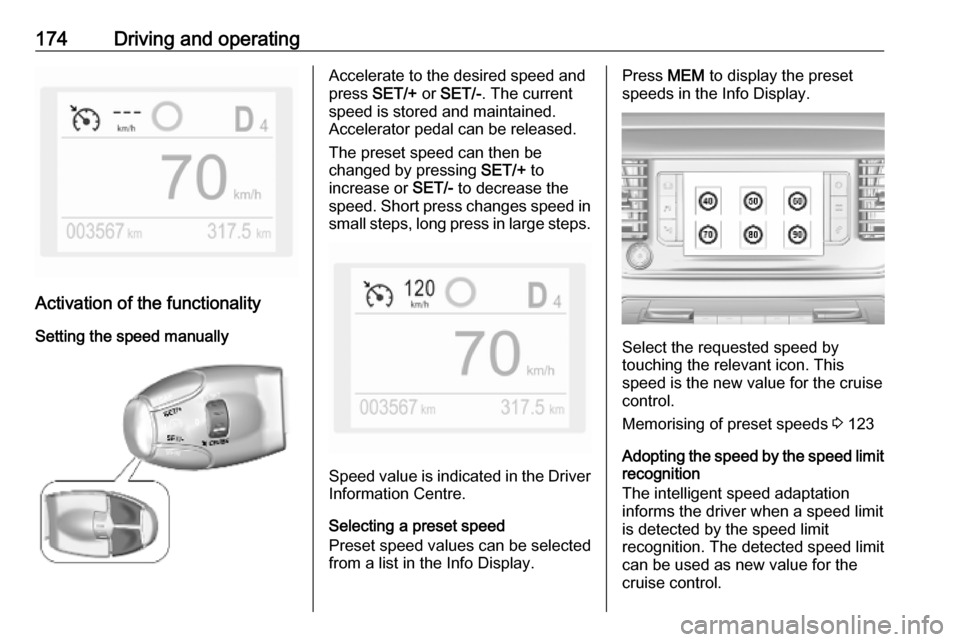
174Driving and operating
Activation of the functionalitySetting the speed manually
Accelerate to the desired speed and
press SET/+ or SET/- . The current
speed is stored and maintained.
Accelerator pedal can be released.
The preset speed can then be
changed by pressing SET/+ to
increase or SET/- to decrease the
speed. Short press changes speed in small steps, long press in large steps.
Speed value is indicated in the Driver
Information Centre.
Selecting a preset speed
Preset speed values can be selected
from a list in the Info Display.
Press MEM to display the preset
speeds in the Info Display.
Select the requested speed by
touching the relevant icon. This
speed is the new value for the cruise
control.
Memorising of preset speeds 3 123
Adopting the speed by the speed limit recognition
The intelligent speed adaptation
informs the driver when a speed limit
is detected by the speed limit
recognition. The detected speed limit
can be used as new value for the
cruise control.
Page 177 of 289
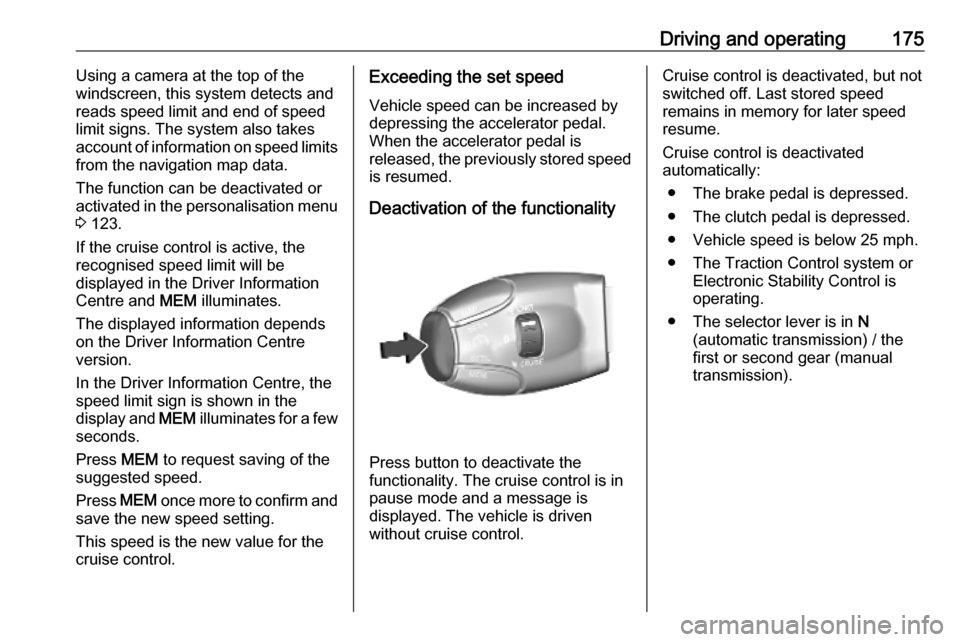
Driving and operating175Using a camera at the top of thewindscreen, this system detects and
reads speed limit and end of speed
limit signs. The system also takes account of information on speed limits
from the navigation map data.
The function can be deactivated or
activated in the personalisation menu 3 123.
If the cruise control is active, the
recognised speed limit will be
displayed in the Driver Information
Centre and MEM illuminates.
The displayed information depends
on the Driver Information Centre
version.
In the Driver Information Centre, the
speed limit sign is shown in the
display and MEM illuminates for a few
seconds.
Press MEM to request saving of the
suggested speed.
Press MEM once more to confirm and
save the new speed setting.
This speed is the new value for the
cruise control.Exceeding the set speed
Vehicle speed can be increased by
depressing the accelerator pedal. When the accelerator pedal is
released, the previously stored speed
is resumed.
Deactivation of the functionality
Press button to deactivate the
functionality. The cruise control is in
pause mode and a message is
displayed. The vehicle is driven
without cruise control.
Cruise control is deactivated, but not
switched off. Last stored speed
remains in memory for later speed
resume.
Cruise control is deactivated
automatically:
● The brake pedal is depressed.
● The clutch pedal is depressed.
● Vehicle speed is below 25 mph.
● The Traction Control system or Electronic Stability Control is
operating.
● The selector lever is in N
(automatic transmission) / the first or second gear (manual
transmission).
Page 178 of 289
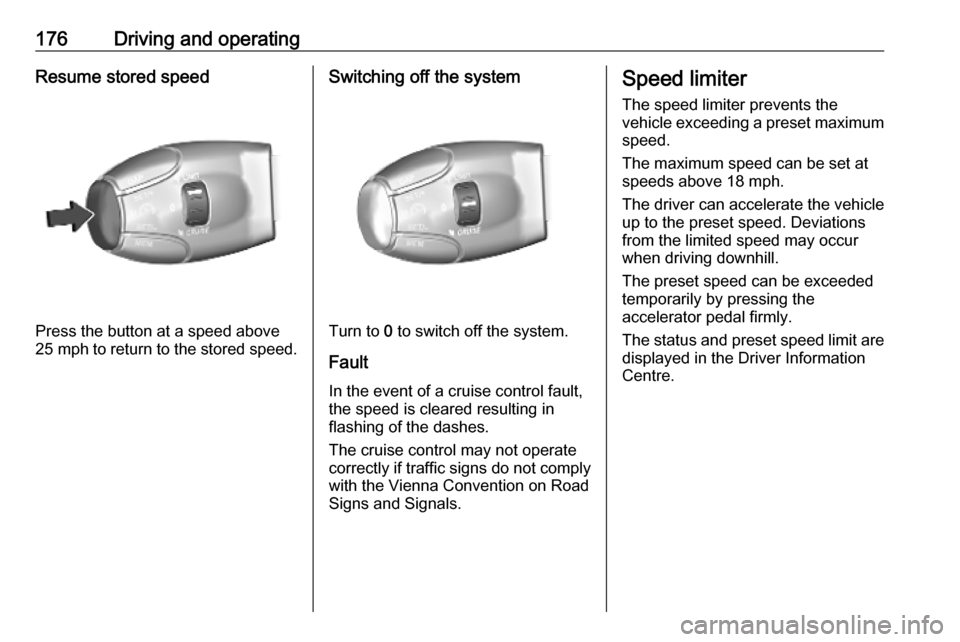
176Driving and operatingResume stored speed
Press the button at a speed above
25 mph to return to the stored speed.
Switching off the system
Turn to 0 to switch off the system.
Fault
In the event of a cruise control fault, the speed is cleared resulting in
flashing of the dashes.
The cruise control may not operate
correctly if traffic signs do not comply with the Vienna Convention on Road
Signs and Signals.
Speed limiter
The speed limiter prevents the
vehicle exceeding a preset maximum speed.
The maximum speed can be set at
speeds above 18 mph.
The driver can accelerate the vehicle
up to the preset speed. Deviations
from the limited speed may occur
when driving downhill.
The preset speed can be exceeded
temporarily by pressing the
accelerator pedal firmly.
The status and preset speed limit are
displayed in the Driver Information
Centre.
Page 181 of 289
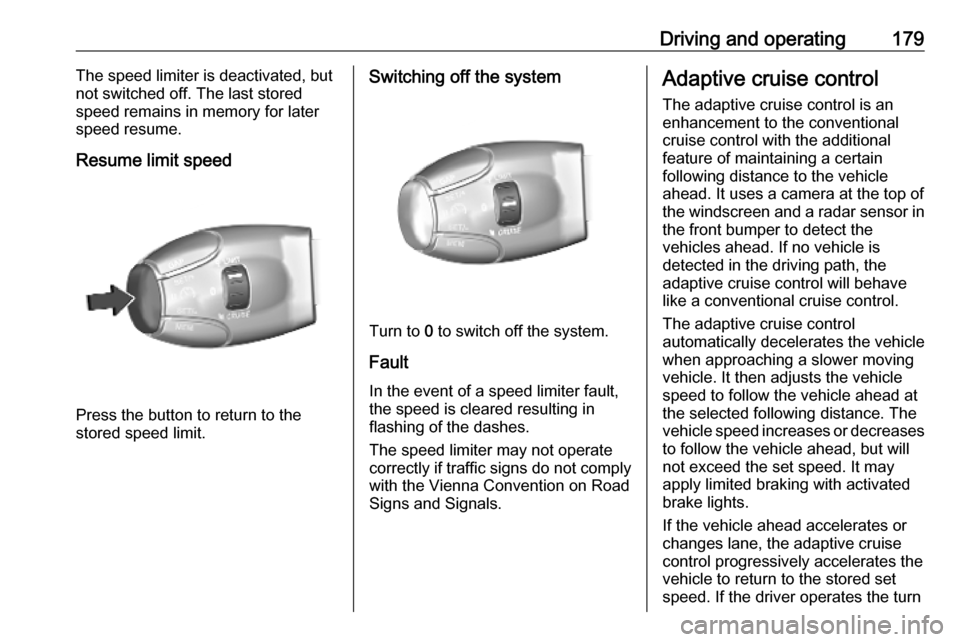
Driving and operating179The speed limiter is deactivated, but
not switched off. The last stored
speed remains in memory for later
speed resume.
Resume limit speed
Press the button to return to the
stored speed limit.
Switching off the system
Turn to 0 to switch off the system.
Fault
In the event of a speed limiter fault, the speed is cleared resulting in
flashing of the dashes.
The speed limiter may not operate
correctly if traffic signs do not comply with the Vienna Convention on Road
Signs and Signals.
Adaptive cruise control
The adaptive cruise control is an
enhancement to the conventional
cruise control with the additional
feature of maintaining a certain
following distance to the vehicle
ahead. It uses a camera at the top of
the windscreen and a radar sensor in
the front bumper to detect the
vehicles ahead. If no vehicle is
detected in the driving path, the
adaptive cruise control will behave
like a conventional cruise control.
The adaptive cruise control
automatically decelerates the vehicle
when approaching a slower moving
vehicle. It then adjusts the vehicle
speed to follow the vehicle ahead at
the selected following distance. The
vehicle speed increases or decreases
to follow the vehicle ahead, but will
not exceed the set speed. It may
apply limited braking with activated
brake lights.
If the vehicle ahead accelerates or changes lane, the adaptive cruise
control progressively accelerates the
vehicle to return to the stored set
speed. If the driver operates the turn
Page 182 of 289
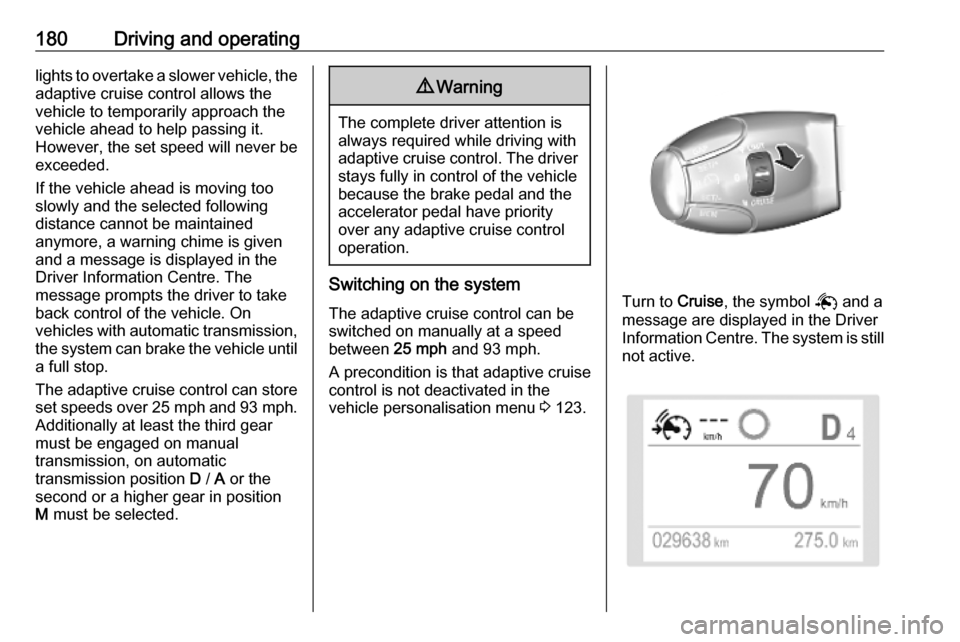
180Driving and operatinglights to overtake a slower vehicle, theadaptive cruise control allows the
vehicle to temporarily approach the
vehicle ahead to help passing it.
However, the set speed will never be
exceeded.
If the vehicle ahead is moving too
slowly and the selected following
distance cannot be maintained
anymore, a warning chime is given
and a message is displayed in the
Driver Information Centre. The
message prompts the driver to take
back control of the vehicle. On
vehicles with automatic transmission,
the system can brake the vehicle until a full stop.
The adaptive cruise control can store
set speeds over 25 mph and 93 mph.
Additionally at least the third gear
must be engaged on manual
transmission, on automatic
transmission position D / A or the
second or a higher gear in position M must be selected.9 Warning
The complete driver attention is
always required while driving with adaptive cruise control. The driver stays fully in control of the vehicle
because the brake pedal and the accelerator pedal have priority
over any adaptive cruise control operation.
Switching on the system
The adaptive cruise control can be
switched on manually at a speed
between 25 mph and 93 mph.
A precondition is that adaptive cruise
control is not deactivated in the
vehicle personalisation menu 3 123.Turn to Cruise, the symbol Q and a
message are displayed in the Driver Information Centre. The system is still not active.
Page 183 of 289
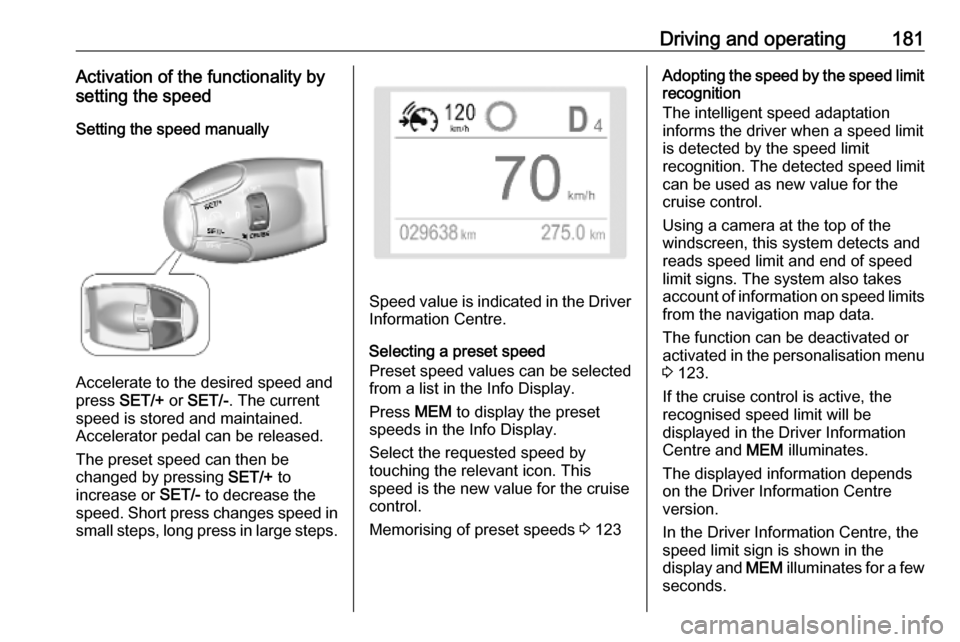
Driving and operating181Activation of the functionality bysetting the speed
Setting the speed manually
Accelerate to the desired speed and
press SET/+ or SET/- . The current
speed is stored and maintained.
Accelerator pedal can be released.
The preset speed can then be
changed by pressing SET/+ to
increase or SET/- to decrease the
speed. Short press changes speed in
small steps, long press in large steps.
Speed value is indicated in the Driver Information Centre.
Selecting a preset speed
Preset speed values can be selected
from a list in the Info Display.
Press MEM to display the preset
speeds in the Info Display.
Select the requested speed by
touching the relevant icon. This
speed is the new value for the cruise
control.
Memorising of preset speeds 3 123
Adopting the speed by the speed limit
recognition
The intelligent speed adaptation
informs the driver when a speed limit
is detected by the speed limit
recognition. The detected speed limit
can be used as new value for the
cruise control.
Using a camera at the top of the
windscreen, this system detects and
reads speed limit and end of speed
limit signs. The system also takes
account of information on speed limits from the navigation map data.
The function can be deactivated or
activated in the personalisation menu
3 123.
If the cruise control is active, the
recognised speed limit will be
displayed in the Driver Information
Centre and MEM illuminates.
The displayed information depends
on the Driver Information Centre
version.
In the Driver Information Centre, the
speed limit sign is shown in the
display and MEM illuminates for a few
seconds.